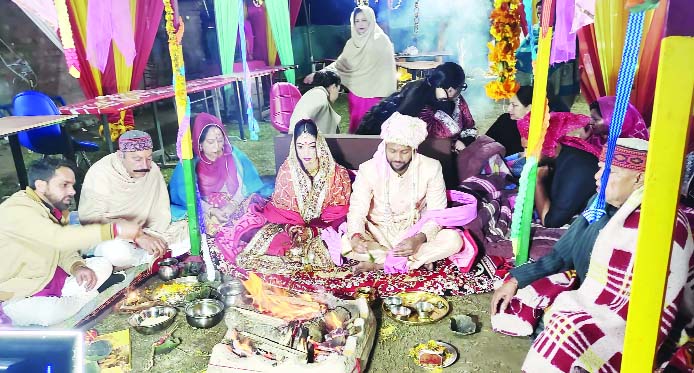Vishal Sharma
To truly understand a society—its cultural values, moral perceptions, and progression—one need only observe its weddings. While there are other methods to gain insights into a community, examining its approach to marriage may be the most revealing. The manner in which weddings are conducted reflects the societal context in which they take place.
Consider, for instance, the evolution of marriage ceremonies in Jammu city. Once simple in nature, wedding celebrations have transformed dramatically over time. While earlier events radiated joy within the family without extravagance, placing emphasis on the ceremony’s essence, today’s weddings have been redefined with spectacular decorations and opulent themes. From elaborate floral entrances adorned with chandeliers to beautifully lit outdoor seating arrangements, the wedding experience in Jammu rivals the grandeur showcased in contemporary TV dramas.
The spectrum of design is vast; whether it be floral motifs, elegant drapes, or vibrant color schemes, modern weddings in Jammu embrace a plethora of styles. They now feature luxurious décor comparable to that seen in Mumbai, leaving no stone unturned.
In the past, weddings were abundant in rituals, spanning weeks leading to the actual celebration. Now, there’s a noticeable shift toward minimizing rituals; only the essentials remain, condensing ceremonies into one or two-day events, in contrast to the month-long festivities of yore.
Previously, an extensive network of extended family and distant relatives descended upon the bride’s or groom’s home days in advance, bringing their belongings and immersing the household in a celebratory atmosphere. This joyous ambience was accompanied by nightly drumbeats, allowing male relatives to unwind with drinks and dance after the day’s labor. Weeks of ladies sangeet festivities would take place, culminating in meals served to the elders by younger family members.
Such traditions are becoming rare; visits from relatives are now limited to a couple of days before the wedding, with many gathering only on the event’s day.
The simplification of ceremonies has been mirrored in the wedding feast itself. Traditionally, meals offered during the saant—a pre-wedding reception hosted by the groom’s family—focused on simple yet delicious offerings. The customary meals during receptions were modest, featuring rice, Indian bread, a few lentils, and vegetables, with sweets like gulab jamun and carrot pudding as highlights. Non-vegetarian dishes were often regarded as taboo, save for certain communities.
However, today’s wedding feasts have embraced a remarkable culinary evolution, incorporating international cuisines like continental, Italian, Chinese, and Mexican, alongside diverse Indian dishes from Punjabi, South Indian, and Gujarati backgrounds. Dining experiences have transitioned from traditional floor seating to lavish buffets offering myriad options, including a rainbow of ice creams and elaborate cakes. The rise in festivities has led to more gatherings thrown by both sides of the family, with cocktail parties now formally recognized—a shift from the discreet revelry of the past.
Changes extend beyond ceremony and cuisine; they are also evident in how individuals celebrate. Weddings now reflect a commitment to looking glamorous. Whereas traditional attire focused on modesty, today’s celebrations encourage attendees to flaunt a variety of styles—from pre-draped sarees to modern lehengas paired with crop tops. Men’s fashion has also evolved, incorporating sherwanis, kurtas, and western outfits into the sartorial mix.
Bridal makeup, previously rare, has become a staple, showcasing elaborate artistry. Modern brides often opt for bold eye makeup, intricate blush, and vivid lip colors, reflecting the current trend toward dramatic aesthetics. Men, too, engage in grooming to enhance their appearances for the occasion.
Among the many trends in contemporary weddings is the enthusiastic embrace of high-fashion couture, even in the biting cold, as young women strut in heavy dresses, seemingly oblivious to their discomfort. This spectacle raises questions about the motivations behind such choices.
Weddings are important cultural milestones, uniting couples and families while offering opportunities for community gathering and celebration. They serve as reflections of our identities, revealing insights about our food, customs, and attire. While it’s essential to celebrate, it is equally vital to question whether current wedding practices align with our values, or if reexamination is warranted.
(The writer is a novelist)


Leave a Reply